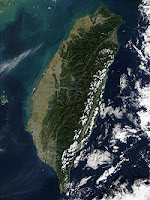Taiwan has amended its Trademark Act May 31, 2011. What has changed?
 |
| Progressive trademark act, but with olfactory deficiency Photo: NASA via Wikipedia |
- Listing counterfeit merchandise online will be punishable by fines of up to NT$50,000 and up to one year in prison.
According to the director-general of Taiwan Intellectual Property Office (TIPO), Wang Mei-hua (王美花) the scope of trademark protection expanded to include:
- animation (movement) and laser logors (hologram);
- three-dimensional shape, colour and sound, already since the Examination Guideline for 3D, Colour and Sound Marks on 1st July 2004;
- and already since the Trademark Act November 2003 word; figure and symbol.
Now a hologram’s graphical representation changes per definition according to the angle you are taking towards it. However, since most intellectual property offices around the world already record the representations digitally, I think it should not have to be an insurmountable problem, as everybody who in the last few years bought a digital camera knows that these cameras include a movie function. So instead of photos, you can easily also make a very high quality movie of any dynamic representation. And even if you insist upon static photo’s, there are cameras that can make a series of stills, each separated from the other by a fraction of a second.
The International Hologram Manufacturers Association (IHMA) is thrilled that Taiwan is the first country to protect holograms as a trademark. According to IHMA, Holograms can play a role in the authentication and detection process against counterfeit products, read here.
Read more about non-traditional trademarks in the archives of Dr. Ralph Sieckmann, here.
- No longer is there a minimum limit for trademark infringement fines of 500 times the unit retail price of the infringed goods. Judges will have full discretion about the amount of the fine.
- Applicants for certificates of origin (Taiwan’s Geographical Indications) will have to use the location of origin or the logo identifying the location in their application in accordance with the Trademark Act.
